
| BMW Garage | BMW Meets | Register | Today's Posts | Search |
 |
|
|
 SUPPORT ZPOST BY DOING YOUR TIRERACK SHOPPING FROM THIS BANNER, THANKS! |
|||||||||
Post Reply |
|
|
Thread Tools | Search this Thread |
| 03-21-2014, 01:47 PM | #1 |
|
Lieutenant Colonel
 946
Rep 1,910
Posts |
Delmarva, Lost and Found
The Delmarva Peninsula is tailor-made for BMW touring, with history, scenery, and relatively little traffic (except on summer weekends). It even has a number of fun roads, although, being a relatively narrow coastal plain in the Atlantic Ocean, there’s not much in the way of elevation changes. The highest point is all of 102 feet above sea level.
I trust you all know that “Delmarva” is short for “Delaware, Maryland, and Virginia.” It is one of the oldest settled areas in the U.S., with Spanish, Dutch, Swedish, and England settlers squabbling over the land starting as far back as 1566. Of course, Assateague and Nanticoke Native Americans lived here as many as 10,000 years earlier and understandably participated in some of the squabbling—effectively at first, but ultimately unsuccessfully, as very few members of these nations remain on the peninsula. I got an early start on February 22, with my first goal being to find the historic Whitehall Manor on the way to the Chesapeake Bay Bridge. It was constructed in 1765-1769 for Maryland Governor Horatio Sharpe. With my usual brilliant navigational schemes, I succeeded in finding its driveway… The manor itself was far out of sight.  As is usually the case, however, one failure leads to another success: In this case, a pretty, early-morning shot across a snowy field.  Minutes later, I motored the ever-willing BMW Z4 3.0i across the Bay Bridge and reached Kent Island on the Delmarva Peninsula proper. Stevensville was named for Francis Stevens, who started a farm here in 1694. The town retains many of its early buildings and much of its original character. This 1880 Queen Anne style church is the latest in a series of five built for the Christ Church Parish, dating back to 1631—making it the oldest continuous Episcopal congregation in the U.S.  This building started life in 1857 as (apparently) an Odd Fellows Lodge. In 1864 it became a Methodist church but later fell out of use. William Denny, III bought it 40 years ago and started Ye Olde Church House Antique Shop and Sheep Farm. When he recently renovated the property, he discovered six 12-foot-high stained glass windows, one of which bears the name of his own great-great grandfather! 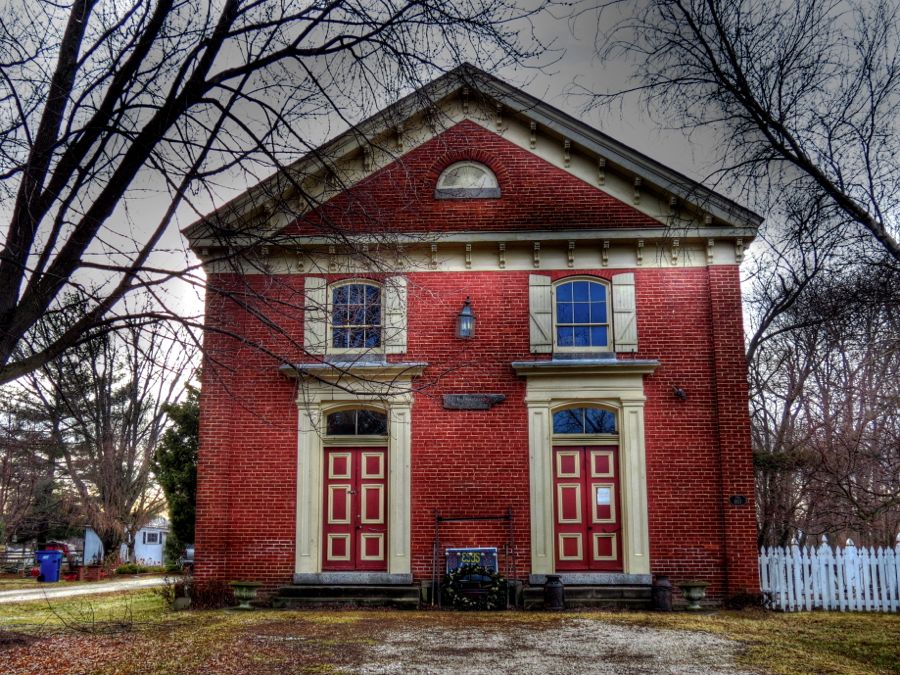 Ship carpenter John Denny built the Cray House in 1809. He started with four vertical posts with long slots cut into them to hold the horizontal wall planks—an unusual method of construction that has held up very well, thank you.  In 1902, the Queen Anne’s Railroad was extended to Kent Island, and this little station served passengers transferring to and from steamships for the trip across the Chesapeake Bay. The railroad closed in about 1952, when the new Chesapeake Bay Bridge made it obsolete. Abandoned and deteriorating badly, the station was rescued by the local historical society in 1988.  This little red schoolhouse near Longwoods, MD is the last of the 43 one-room schools that populated Talbot County, Maryland in the 1860s. Remarkably, it was still used as recently as 1967. It is now a museum, open by special arrangement. 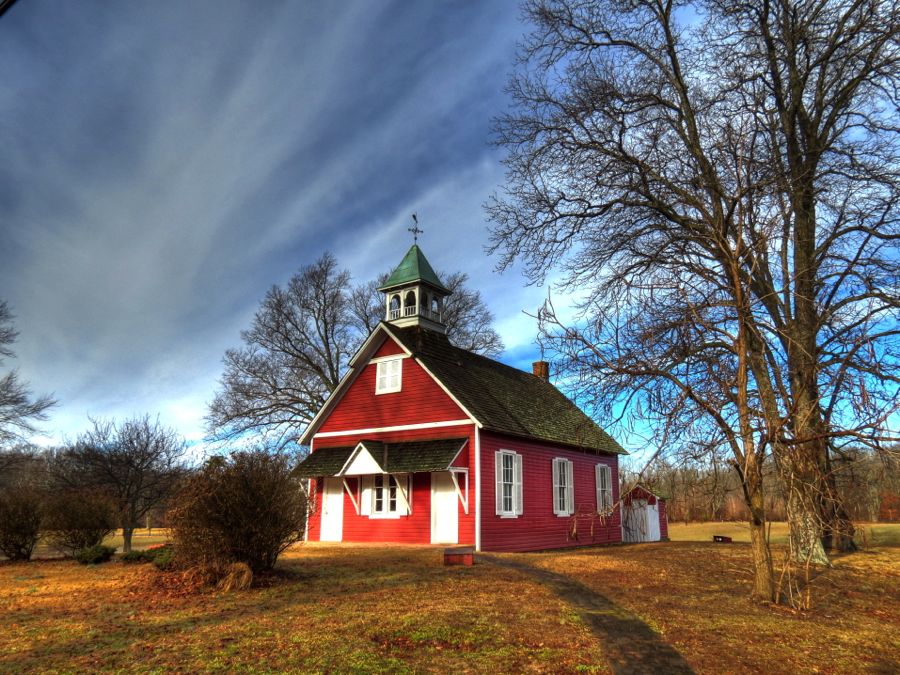 All Saints’ Church was built in 1900-1901, replacing an earlier church that had burned. It features an asymmetrical “Carpenter Gothic” design, a massive, three-level bell tower, and stained-glass windows imported from Munich, Germany. On the day of my visit, it looked like preparations were underway for a new coat of paint and other repairs.   In contrast, St. John’s Chapel has sat abandoned since 1895. Compared to the historical photo, its continuing deterioration is quite apparent. When St. John’s was built in 1835 near Easton, MD, it was the first Gothic Revival church on the Eastern Shore of Maryland. Best to visit St. John’s sooner rather than later.   The chapel is situated on the north bank of the Miles River. It’s not visible in this photo from the south bank, but The Anchorage is. The center section of the stately mansion was built in 1810, around a small, nondescript brick dwelling from about 1720. The wings and connecting “hyphens” were added in the 1830s. If you look carefully at the close-up view, you’ll see a tower-like windmill behind the wing on the left.   Speaking of stately mansions, I couldn’t get remotely close to Otwell, which was built in the early 1700s. I had to settle for this photo from 1936.  To console myself, I detoured over to nearby Oxford, MD and its scenic harbor. As with most colonial harbor towns of the period, arriving ships had to pay customs duties on goods brought to America. An exact replica of Oxford’s original 1600s’ customs house was built in 1976. As it happens, every month such “goods” included hundreds of human beings captured in Africa and brought to America as slaves. Many a ship full of such unfortunate victims arrived in Oxford’s port, to be sold throughout Maryland and the South. With the abolishment of Atlantic slave trading under the new United States Constitution, Oxford began a long period of decline. 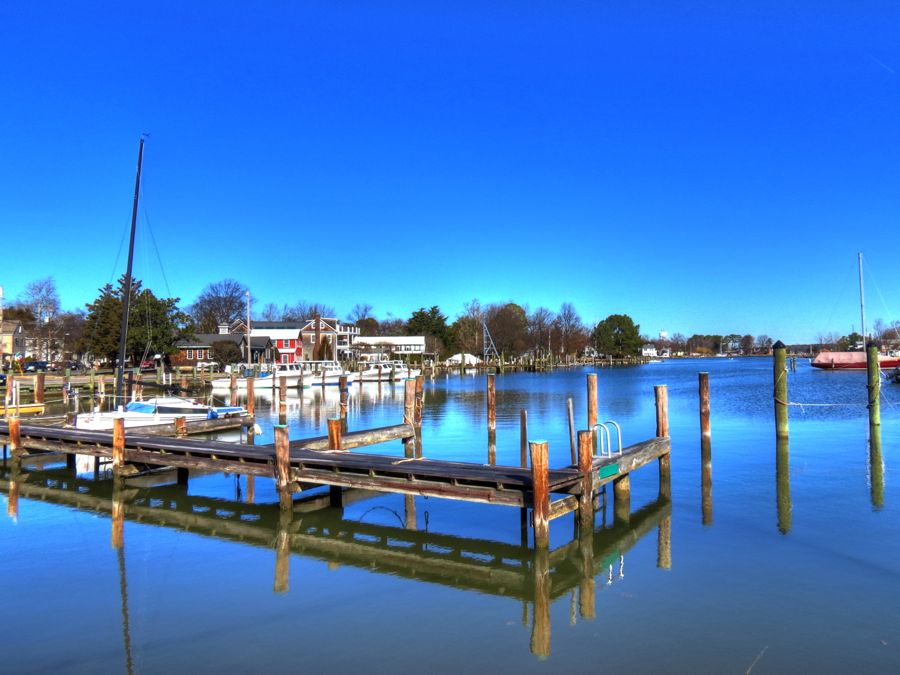  Not far from Oxford, I noticed “Screamersville Road,” and I made a mental note to find out if there was, in fact, a town named “Screamersville” somewhere in Maryland. Sure enough… Enter Jeremiah Banning, who was a sailor for much of his life and became Oxford’s Customs Collector in the late 1700s. By this time, Banning owned 35 slaves, most of whom he had personally brought back from Africa. When he became a devout Methodist, however, he came to the realization that slavery was “wrong, inhumane, and against God’s command.” He immediately freed a number of his slaves and made provision for the others to be trained in various occupations, with their freedom granted by a specified age or at the end of their apprenticeship. Banning’s freed slaves established a small town called Screamersville, centered on a chapel they built and named after John Wesley—the founder of the Methodist movement. On my next venture into this area, I will try to find what’s left of the community. Continuing on down the Delmarva Peninsula, I ran across this reminder of my misspent youth. In fairness, I never owned (or decorated) a VW bus, but I did drive one owned by a friend who gave me my first paying job when I was 15. (This same friend later helped me get my first professional job and even later yet became my crew chief throughout my SCCA racing days during 1985-1993. So here’s to you, Phil Sibert!)  My route for this 2-day trip came from Great Roads, Great Drives, by Jennings Glen and Dan Bard. I added a few modifications of course, one of which was to find this modest house in Cambridge, MD that looks out over the Choptank River. Why bother? Because this home was built in 1913 by one Annie Oakley and her husband for their retirement. 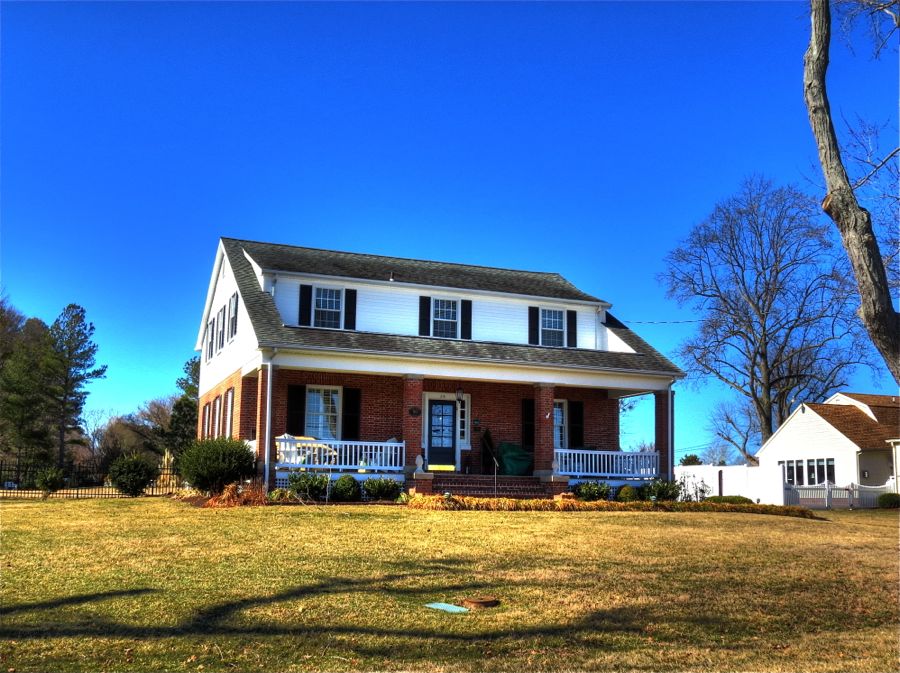 Annie Oakley, of course, was the legendary sharpshooter who thrilled audiences across the country from age 15 through her sixties, performing with Buffalo Bill’s Wild West and other shows. One of her signature trick shots was to aim at a playing card—positioned toward her edgewise—from 90 feet away. Her first shot with a .22 rifle would split the card in two; subsequent shots would pierce the pieces of the card multiple times before they fell to the ground! Oh, and she also shot cigarettes held in her husband’s mouth, performed for Queen Victoria of England, King Umberto of Spain, President Carnot of France, and many others. At the request of Germany’s Kaiser Wilhelm II, she shot the ashes off of the cigarette he was holding. Some years later, after World War I had broken out, she wrote to the Kaiser and asked for a second opportunity to shoot at him! Chief Sitting Bull was so taken with her skills that he adopted her as a daughter and member of the Lakota tribe and gave her the name “Watanya Cicilia,” which means “Little Sure Shot.” Thereafter, Annie Oakley always referred to him as her adopted father. She died of pneumonia in 1926, at the age of 66. Among the various places Annie owned or lived in over the years, the house in Cambridge is the only one that is still standing. (Perhaps all the others were shot to smithereens?)   The Eastern Shore of Maryland has its fair share of once-proud, now-abandoned homes, and they always strike me as both sad and beautiful. I spotted this one just west of East New Market. It still has its original staircase to the high first story, which was a fairly common design farther south.  I found another one, complete with old barns and sheds, outside of Hurlock, MD, not far from the Delaware line. I’d love to see every one of these places renovated and saved for future generations, but the odds are against it. While mega-farming continues to be a very profitable business, the fate of small family farms seems to have been sealed for a long time now, with or without Federal subsidies.  The town of Hurlock owns this old railroad station, and it features prominently in their annual Fall Festival. For $8.00, you can ride in one of the town’s old railroad passenger cars from Hurlock to Federalsburg and back. Once you’re back, you can enjoy the antique automobile and motorcycle show, along with many other attractions. In the dead of winter, however, there was not much going on other than a good, stiff breeze.  The Hurlock Station, incidentally, predates the town itself. Once the station was built in 1867, the railroad line began to attract businesses, families, and churches, and the town itself incorporated in 1892. The Glen Oak Hotel was built here about 2 years earlier, when the Baltimore, Chesapeake, and Atlantic Railroad added a line to the town, complementing the existing Dorchester and Delaware Railroad.  Once I crossed into Delaware, I took Woodland Ferry Road toward the Nanticoke River. Captain James Smith had explored this river in 1608, encountering the Nanticoke Indians (translated as “people who canoe the tidal stream”). The ferry across the river is one of the oldest in continuation operation in the U.S. It has been operating year-round since about 1740, originally run by James Cannon and his descendants and subsequently, without charge, by Sussex County since the 1850s. Unfortunately, it was not operating on the day of my visit, having just shut down for extended reservations. I was left gazing longingly at the far side of the deep and fast-moving river… 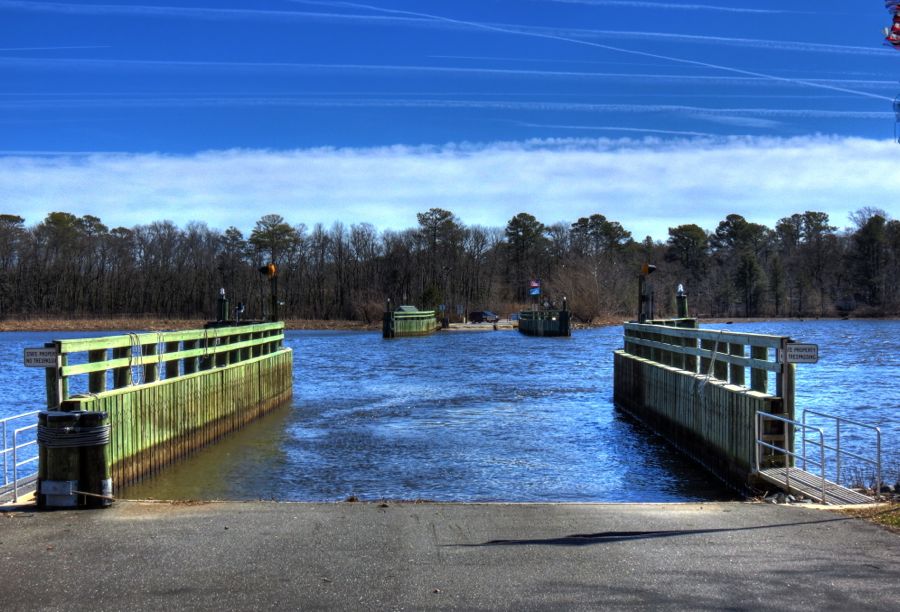 Near the missing ferry was the partly missing Cannon Hall. Jacob Cannon had the house built in 1810 for himself and his bride-to-be—who jilted him at the last minute. Poor Jacob was so distraught that he never moved into his new house, and it sat vacant for the next 20 years. In the meantime, he became an embittered ferryman, landholder, and lender, frequently foreclosing on his neighbors. After Jacob’s death, his sons Jacob, Jr. and Isaac continued the family tradition, with the latter said to have “emptied victuals from cooking pots and took beds away from the sick in an effort to collect his debts.” If that wasn’t bad enough, Jacob, Jr. was shot dead in 1843 in a heated dispute over a hollow log that served as a beehive. He was so hated that his killer was allowed to waltz away without punishment. Oh, and I haven’t even mentioned their relative Patty Cannon. My dedicated readers may remember that she was infamous for kidnapping free African Americans from around the Delmarva Peninsula, taking them south (often using the family’s ferry, it is said), and selling them into slavery. For unclear reasons, her skull is kept in a hatbox in the Dover Delaware Public Library. Anyway, Cannon Hall was thoroughly renovated in 1972 and prospered until October 2010 when a devastating fire gutted much of the main part of the house. However, it appears to be in the process of rebuilding. (Historical ferry photo courtesy of Woodland Ferry: Crossing the Nanticoke River from the 1740s to the present, which also has a fascinating summary of the Cannon family.)    The missing Woodland Ferry necessitated a detour through Seaford, DE. While crossing its bridge over the Nanticoke, I spotted the town’s old railroad station and went to have a look. Although the railroad tracks are still in use, the station has been vacant for many years.   Eventually I reached Broad Creek, where I would have arrived 30 minutes earlier had the ferry been operating. After looking at this odd bridge across the creek for a little while, I realized that it’s a drawbridge, with a huge overhead counterweight to help lift the deck of the bridge. This one uses a curved “rolling lift” design, kind of like the base of a rocking chair.  Speaking of odd contraptions, note the pole standing in front of my faithful Z4, with the white ball suspended from it. (From the pole, Willis, not from the car!) Back in the day before semaphores and electronic signals, railroad workers would hoist such balls to the top of their travel to signal approaching trains that the track ahead was clear and they could proceed at full speed. Otherwise, the ball would be lowered into the box and not be visible, indicating a blocked track. Ever heard the expression “highballing right along”? Now you know. This one is located in Delmar, which, as you may have guessed, is right on the southern border between Delaware and Maryland.  My primary destination for the day was Salisbury University, where I’d arranged to meet family friend Elissa Laib and see her art exhibit New York for a Day: A Collection of Street Photography. Despite detouring around the missing ferry, I was still on schedule, so I went looking for the Gillis-Grier Victorian mansion, built in 1887 by James Cannon (a relative, no doubt, of the infamous clan from Cannon’s Ferry). I found two such mansions in the right vicinity but wasn’t sure which one was the correct one. Turns out that the Newtown section of Salisbury is full of such mansions, and neither one of these was the right one… Those evil twins, Garmin and Google strike again! The correct one, unbelievably, is even more ornate.   Despite my Directional Confusion, I managed to find the Guerrieri Center at the University without difficulty and met Elissa on time. She’s a senior art major, and it was fascinating to look at her photographs and learn about the techniques she used to capture the photos, develop the film—yes film; no digital shortcuts for this artist!—and to print the results. In the process, I learned about the several different ways to hand-tint black and white photographs, different color filter approaches in chromogenic prints, how Ansel Adams’ methods predated modern HDR (“high dynamic range”) photography by almost 100 years, and a number of other pro techniques. It was clear to me that she has been studying diligently, and practicing everything she has been learning. I’m also proud to say that one of her excellent photos is now in my possession. Thanks, Elissa, for your hospitality and for the mini-education!  On my way out of Salisbury, I looked for the old Pine Bluff Sanatorium but found nothing of interest among the modern retirement apartment complex that is now located there. (Oh well…) With some difficulty, however, I managed to get a distant look at the Old Yellow Brick House near Nanticoke Road. More properly known as “Moorfield,” this Federal-style home was built sometime between 1810 and 1820. Compared to the photo from 1979, the house has clearly been renovated and added onto—but it nonetheless looked a bit vacant on the day of my visit.   There were signs of the prior day’s rains everywhere I went on the peninsula. Sometimes the standing water just looked like an inelegant mosquito-control system; other times, fortunately, it was downright scenic.  In the 1800s and early 1900s, steamships operated on many of the rivers on the Delmarva Peninsula. Whitehaven, MD, on the Wicomico River, was a popular spot for tourists and business people alike. Whitehaven remains a beautiful little riverside town, bypassed by most progress after the mid-1800s. The only surviving commercial building is the Whitehaven Hotel, from about 1810. These “Second Empire” style hotels were once quite common, but now only two or three are left in Delmarva. Based on the historical photo, guests thoroughly enjoyed the place back in the day.   Another notable survivor is the Whitehaven Ferry, which I was pleased to discover was actually operating as scheduled. While the Woodland Ferry might date back to 1740, Whitehaven has been around since at least 1688. It duly hauled the BMW across the Wicomico for a charge of exactly $0.00. I even got a friendly wave from the pilot as I wandered around taking pictures.   A small African-American community has existed at Hungary Neck, outside of Princess Anne, MD, since before the Civil War. The residents built the handsome Mt. Zion Methodist Church in 1887, replacing an earlier (and simpler) meetinghouse. It retains its asymmetrical Gothic Revival design and is still in use. Almost all of the graves in the cemetery are aboveground vaults, apparently because the land is so low that it is frequently saturated with water.  Continuing on toward Princess Anne, with the sun getting ever lower, I reached the location of Waterloo mansion, which dates back to 1750—only to discover that trees and bushes blocked every possible vantage point. Unless, of course, one were to hike to the opposite end of the lake on Monie Creek, wade through some squishy wet ground, carefully walk across piles of matted river grasses, and stoop down beneath overhanging branches, just to get the following photograph for you all… Waterloo was built for Henry Waggaman, a prominent landowner and merchant. It was owned by several different families until 1864, when Wicomico County purchased the property and used it as an almshouse. It later reverted to private ownership, and, until recently, was a bed & breakfast.  The Dead o’ Winter can be a tough place to find colorful settings for photos, but I liked how the low sun lit up the marsh grasses behind the Z4.  With the last of the sunlight, I managed to get quick photos of the huge, five-part 1802 Teacle Mansion in Princess Anne, now home for the Somerset County Historical Society…  …as well as my old friend the 1883 St. Paul’s Methodist Episcopal Church. I was pleased to see that it was still standing, but the bell tower was not leaning when I first “discovered” the church a couple of years ago (see A Biplane Dive-Bombing a Baptist Church?? Yep…. Its days may be numbered. Like many churches in this area, St. Paul’s was built from a mail-order design (number 19A), which cost as little as $3.50 from the Catalogue of Architectural Plans for Churches and Parsonages.   Although the sun had disappeared completely, I still managed to get this faint photo of the ruins of the 1785 Coventry Parish Church. By law, the (Anglican) Church of England had been the official church of Maryland since 1692, but the denomination largely disappeared in the U.S. following the Revolutionary War. It was slowly reinstated as the Episcopal Church, and Coventry Parish was possibly the first such church constructed after the revolution. Given the denomination’s unpopularity in general at that time, the size of this church (two stories, 76 feet by 50 feet) indicates a surprising degree of loyalty among the well-to-do planters in this area. About 100 years later, however, the Coventry Parish Church was abandoned.  After considering the darkness, the rapidly falling temperature on this February day, and my general state of being lost in Delmarva, I put the top up, hauled out the iPhone, and asked Siri to find the nearest motel. Remarkably, she found a Holiday Inn Express in Pocomoke City, only 6 miles away—and it even had a Ruby Tuesday next to it. Cold and exhausted, but invigorated from my touring, I was there in a flash. DAY TWO I was off again the next morning, quickly crossing over into Virginia and searching for the ruins of the Mason House near the inelegantly named town of Bloxom. As it turned out, getting a good look at the house would have required a canoe, and I hadn’t thought of bringing one with me. According to the Library of Congress, the Mason House would have looked approximately like this (in 1960, anyway):   I consoled myself with a drive around the old railroad village of Bloxom, which, unfortunately, appeared well on its way to becoming a ghost town. Roughly a third of its houses and buildings were vacant, including the local high school, which closed in 1998. The volunteer fire department burned to the ground in 2006, while the volunteers were fighting a blaze elsewhere. Such sights are becoming all too common in many rural and urban parts of the U.S. Solutions are not obvious but probably involve doing a much better job of “keeping up with the times”—for individuals and businesses alike. Easier said than done, of course. For now, it’s sad to see these once-thriving towns slowly wasting away.    However, for anyone in search of “barn find” automobiles, Bloxom might be just your place. I have no idea what model of car this is, other than early 1940s American. Like much of the rest of the town, it is in serious need of restoration.  A little further south on Virginia Highway 316 brought me to Parksley and the Eastern Shore Railroad Museum. A tour costs all of $2.00 and includes the old railroad station…  …several passenger and mail cars…  …and this 1913 boxcar, which was converted to track-maintenance duties in 1969 (thereby explaining why a boxcar would have windows on the side and doors at each end). 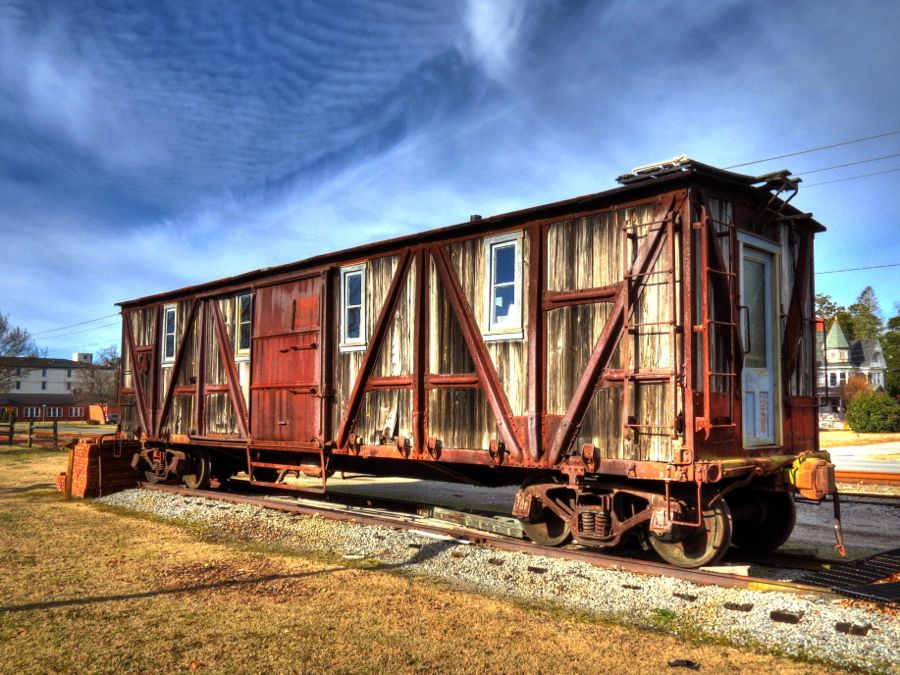 Elsewhere in Parksley, I spotted an old hotel, a number of nice Victorian houses, and the ubiquitous statue in honor of Confederate Army soldiers. An inscription on the base of the statue read “They Died for the Principles Upon Which All True Republics are Founded.” Did I mention something about the importance of keeping up with the times?  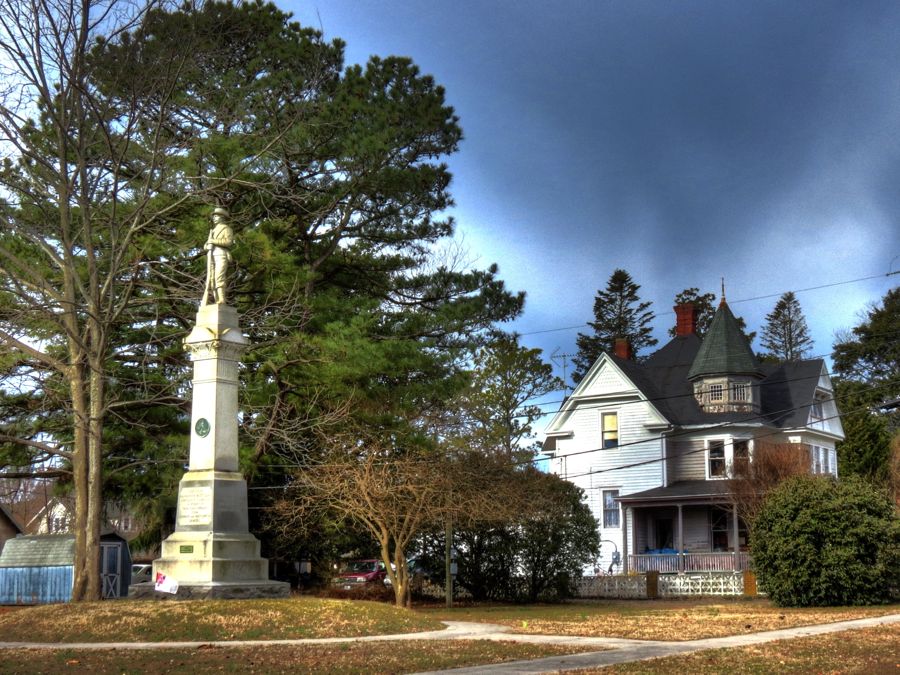 I’d never seen a debtor’s prison before (honest!), but the nearby town of Accomac had one. It was built in 1783, originally as a residence for the town’s jailor and converted in 1824 to comply with a new law requiring that jailed debtors be kept separate from run-of-the-mill felons in the prison system. The building is virtually unchanged from its original form and is the oldest building in Accomack County.  I found a few other interesting sites in Accomac. What got me started was this slightly haunted-looking gate, which just had to have an interesting house behind it. (It did.)   The even-more-stately (if less haunted-looking) Drummond Place was next door. Accomac was originally called Drummondtown, after Richard Drummond who owned much of the property here. This house was built in the late 1700s. (Drawing by local artist Katharine B. Pennebaker, courtesy of the Eastern Shore Public Library.)   When I parked on Back Street in Accomac to look at the houses, I didn’t initially notice the magnificent beech tree right in front of me. Its barren branches made quite a fractal-like sight.  Other houses in Virginia were a lot less stately but much more whimsical. One such place in Onley featured an astonishing collection of lawn statues, old spring-mounted hobbyhorses, toy boats—you name it. It was impossible to get them all into a single camera frame, so here is a 1-percent sample for your enjoyment.  On Seaside Road, outside of Painter, I stumbled across this striking view of an abandoned house sitting forlornly under dramatic skies. As best I could tell, someone has been harvesting its siding for other purposes, leaving just the skeletal remains. (Golly!)   I’d read about the Willowdale Mansion while planning this trip, and I knew that its original section had been built in the late 1600s, with subsequent sections added using the “big house, little house, colonnade, kitchen” style of expansion. However, based on the old photos from the National Register of Historic Places, I expected to find only the ruins of this once-stately home.   Imagine my surprise when I pulled up to a nice-looking house, with no signs of ruins other than a very old-looking fireplace at one end. I was, uh, “greeted” by an energetic guard dog, but was soon rescued by a very pleasant young woman named Amy, who lives here with her husband, son, and mother. She explained to me that her mother had been rescuing Willowdale from near collapse for the last 10 years and was close to finishing its complete renovation! In the photo below, the earliest portion of the house was at the far left, where the brick wall and fireplace still stand. The right half of the 2-story “big house” (and, for that matter, much of the second story itself) was added in 1728. The 1½-story section on the right was the original kitchen, from the early-to-mid 1800s. The colonnade connecting the main house and kitchen was enclosed later in the 1800s, forming the “little house.”  Sadly, about half of the very oldest portion of the house could not be saved, but Amy’s mom, Catherine, cleverly left the brick end section and brick foundation in place, in effect creating Virginia’s oldest patio!  Otherwise, over the last 10 years Catherine has painstakingly restored Willowdale at her own expense, a piece at a time. In the process, she has dedicated countless hours to the project and become an expert in the history of this part of Virginia. One of the most remarkable facts about Willowdale is that it has been owned by the same family since John Smith first received the land patent in 1666. Catherine and Amy are direct descendants of John Smith. (She was careful to note that he was not the John Smith, of Jamestown fame, but a somewhat later person of the same name.) Amy was very generous with her time, telling me about Willowdale and its history. She also mentioned that the house sits very near the Machipongo River. At high tide and with a full moon, entire sections of its long dirt driveway are under water! As she was relaying Willowdale’s story, her young son James appeared far more interested in continuing the centuries-old history of farming.  With a cheery wave from Amy (and a final bark from Sheba the guard dog), I bumped and slithered my way back down the long muddy driveway. Thanks, Amy, for your hospitality, and thanks, Catherine, for rescuing this remarkable dwelling! As I continued on toward Cape Charles, near the southern-most end of the Delmarva Peninsula, I encountered two schools. The first one, near the town of Exmoor, appears to have suffered a devastating fire. It would definitely benefit from Catherine’s restoration magic.  The second one was the Cape Charles Colored School. It was built in 1928 with financial assistance from Julius Rosenwald, one of the founders of Sears Roebuck. He had been inspired by Booker T. Washington and created a foundation that helped build more than 5,000 schools and teachers’ residences for African American students across the South. During the years of segregation—and afterward—this school taught black first- through sixth-graders from Cape Charles with a staff of only three teachers and one principal. It closed in 1966, 2 years after the Civil Rights Act of 1964 but 4 years before schools in this area were integrated. One of its best-known graduates was Johnny “Red Ball” Sample, whose father owned the town’s barbershop. Johnny went on to an outstanding career in professional football, winning the NFL Championship in 1958 (long characterized as “The Greatest Game Ever Played”), and the AFL Championship and World Championship (Super Bowl III) in 1968.     A high overpass leads from the school to Cape Charles—and provides a scenic overlook for the once-thriving railroad yard just outside the town. Cape Charles was founded in 1884 as a “planned community” by the New York, Philadelphia, & Norfolk Railroad and the Cape Charles Ferry. Located at the mouth of the Chesapeake Bay, Cape Charles served as the eastern end for ferries transporting people, automobiles, and railroad cars across the Bay to Norfolk and Virginia Beach.  The passenger ferries closed in 1963, following completion of the Chesapeake Bay Bridge-Tunnel system. However, barges continue to carry railroad traffic across the Bay, departing from odd-looking piers such as this one, where railroad tracks lead right out onto the water and then abruptly end. No one seemed to mind an odd-looking photographer driving about and snapping pictures. 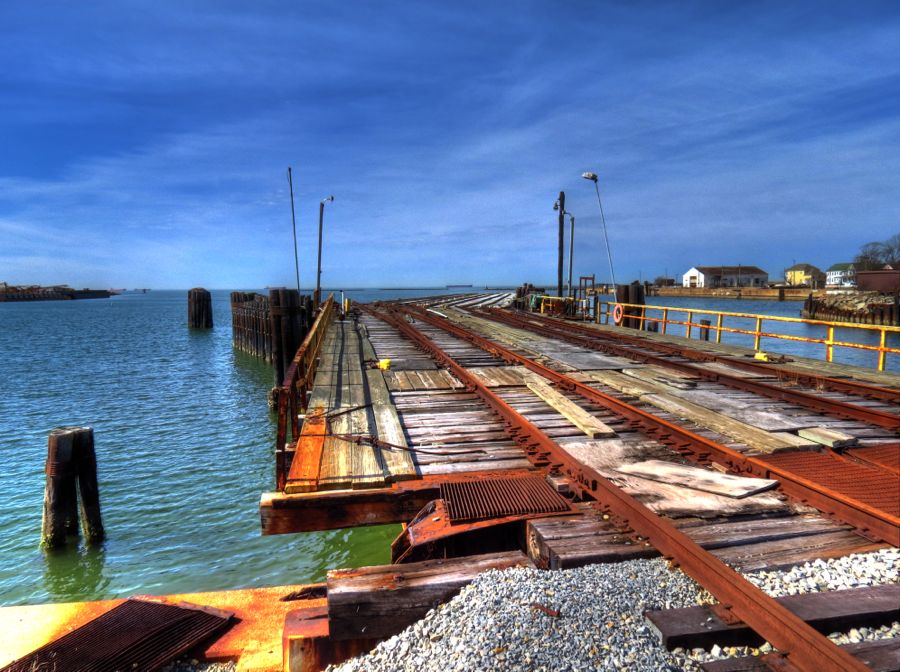  Cape Charles continues to be a popular resort spot, with a nice beach on the Chesapeake. The entire town is listed on the National Register of Historic Places, and it merits a longer return visit.  By now it was afternoon, and I was less than a tenth of the way through the route for my second day. (Never fails!) I hit the Bay Bridge Tunnel running, and $13.00 and 23 miles later I arrived in Virginia Beach. It’s not easy to take a 3-exposure HDR photo one-handed while driving in a crosswind, but here’s my attempt. The area that I was driving across, incidentally, was formed about 35 million years ago when a large meteorite struck Earth at roughly 750 mph, creating a crater 24 miles in diameter and almost as deep as the Grand Canyon. The tsunami resulting from its impact likely caused ocean waters to break over the top of the Blue Ridge Mountains.  If you’re at all nervous about crossing long bridges, try not to think about this event the next time you’re on the Bay Bridge-Tunnel… Interestingly, the impact crater was not discovered until 1983, when a drilling core sample off the coast of Atlantic City, New Jersey turned up fused glass beads and grains of “shocked” quartz, which are characteristic of meteorite strikes. Having avoided any further meteorites as I crossed the Bay, I had only one destination in mind for Virginia Beach: To find “Ye Dudlies,” the oldest, continuously lived-in home in all of Virginia. The Adam Keeling House, as it’s better known, was built sometime in the 1680s and remained in the Keeling family until 1881. I could see this much of the house from Adam Keeling Road, but a better look would have required walking through people’s front or back yards in the surrounding modern housing development.    Next up was a trip across Hampton Roads (a natural harbor formed by the mouths of the James, Nansemond, and Elizabeth Rivers) and a visit to Fort Monroe. It is the largest stone fort ever built by the U.S. military. Defensive fortifications in this area date back to 1609, with Fort Monroe’s construction completed in 1834. It features seven large bastions and is surrounded by a huge moat. (Aerial photo courtesy of the U.S. Army.)    As it happens, any old history-seeking photographer can drive right on into Fort Monroe (although it helps to have a relatively narrow car). The facility remained in Union hands throughout the Civil War, despite Virginia’s secession, and the famous Battle of Hampton Roads took place south of here in 1862 between the CSS Virginia (formerly USS Merrimac) and the USS Monitor. Following the war, Confederate President Jefferson Davis was imprisoned at the fort for 2 years, initially in crude quarters in the casement walls and later in a more comfortable setting.    Fort Monroe was also the setting for Union General Benjamin Butler’s historic 1861 decision to treat escaping slaves as “contraband.” This pejorative-sounding doctrine granted freedom to any escapees who could make their way to Union forces—including Fort Monroe, which became known as the “Freedom Fort” among African Americans. (Drawing courtesy of “Fort Monroe designated a National Monument”.)  After touring the old part of the fort, I used its later, World War II-era ramparts to get this photo of the Old Point Comfort Lighthouse. The lighthouse was built in 1803 and, remarkably, survived both the War of 1812 and the Civil War and is still in use today. The lighthouse keeper lived in the dwelling shown just to the left of the light in this photo.  In 1834, the fort’s cannon could fire a 32-pound shell approximately 1 mile. By World War II, artillery technology had advanced to the point that the fort could fire a 2,000-pound projectile as far as 25 miles. The newer ramparts still house some of the guns used by the Coast Guard Artillery School, not to mention a scenic old window or two.    After hiking back down from the walls, I discovered a historic customized 1959 Edsel hardtop. Its owner acquired the car a few years ago from one of the enlisted men stationed here and set about modifying it in a way consistent with customizing practices in the late 1950s—e.g., two-tone paint, pinstripes, teardrop spotlights, Cragar wheels, and various auxiliary gauges. Very nice! (And it brought back more memories from a misspent youth.)   I finally took my leave from Fort Monroe, now hopelessly behind schedule. Eager to make progress but unable to help myself, I stopped almost immediately past the exit of the fort for a photo of this Hampton Roads fishing boat.  After crossing the York River and entering Gloucester County, I found the glorious 1894 Zion Poplars Baptist Church. It was quite a sight, and I learned that it served not only the religious needs of its independent African American congregation but also their economic and educational needs. Before the church was built, slaves and free blacks would gather here beneath seven popular trees that were joined by a common base. Such “brush arbors” offered a safe haven for slaves who were otherwise banned by law from assembling “to give, or receive, educational or religious instruction.” Following minister Nat Turner’s Rebellion in 1831, these laws were expanded to apply to free blacks as well. Zion Poplars was named in honor of the history that took place on these grounds. Four of the original conjoined poplar trees survive to this day and are partially visible behind the church in this photo.  The Ware Parish Church was constructed in 1715, replacing an earlier one from 1660. It started life as an Anglican (Church of England) denomination and, like so many others, was abandoned following the Revolutionary War. It was later rescued by Methodists, and later still renovated as an Episcopal church.   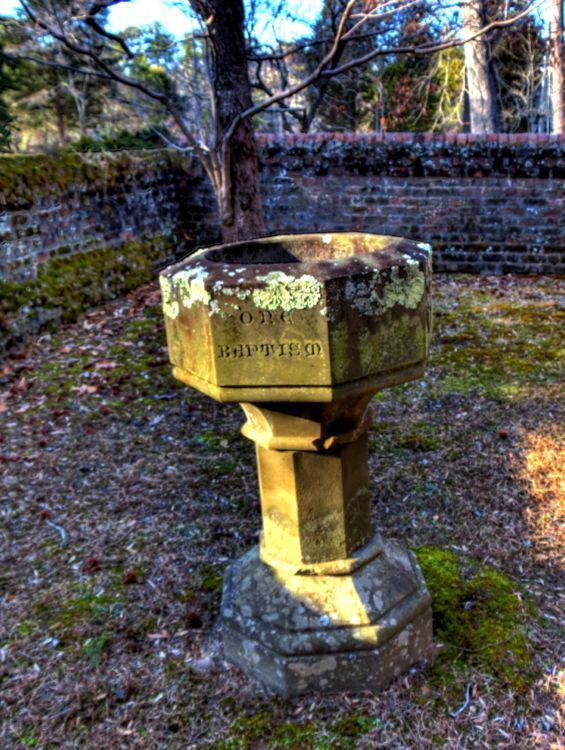 This lonely silo was about all I could find of Nuttall, Virginia. There’s probably more to the town somewhere, just in case there’s anyone reading this whose name might be Nuttall… 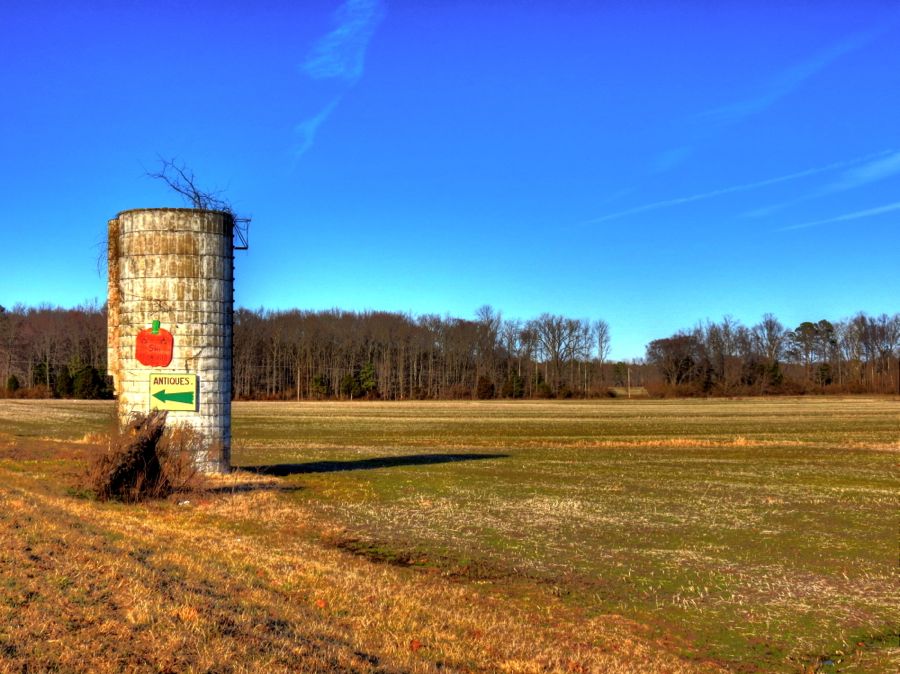 During the Civil War, many “forts” were constructed in the form of trenches and earthen embankments. One such Confederate fort was positioned near the North River, for the purpose of defending Gloucester against an attack from the east. It stood at a key crossroads on the approach to Richmond. In October 1863, Union Gen. Isaac Wistar approached this fort from Gloucester (i.e., from the west) and managed to capture it with no resistance whatsoever. The fort’s builder, Mr. W. Dawson Soles, commented “What a piece of nonsense!” Ever after, the place has been known as Fort Nonsense. It is one of the best-preserved earthen forts in the country.  With the sun beginning to set, I had just enough time for glimpses of a few more historical sites. First up was Wilton Manor, a large plantation house built in 1763 by William Churchill, an ancestor of Winston Churchill. It is one of the finest and most original plantation houses in Tidewater Virginia. 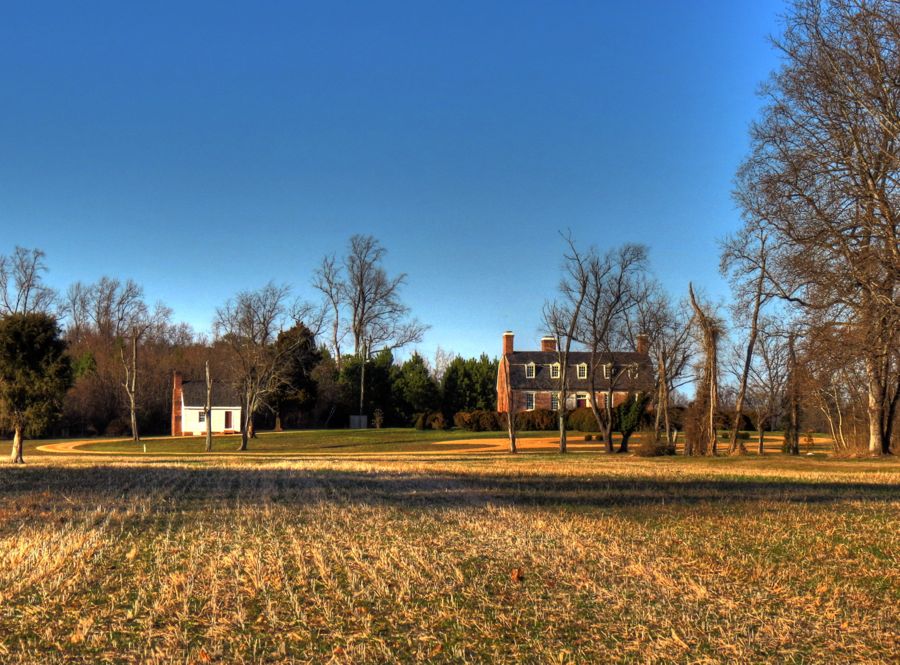  Next was the 1717 Lower Church, with its very unusual “clipped gables.”  I stopped briefly to revisit the 1730 Christ Church, arguably the most original church in Virginia (see Ports—Royal and Otherwise. Nobody minded me wandering about for a quick photo, perhaps since nobody else was there at all.  Finally, with the rays of the sun arriving almost horizontally, I captured this photo of the 1906 Shiloh School in the vicinity of Ball Neck, VA. The first teacher at this remote one-room schoolhouse was 22-year-old Jessie Dew Ball, who was born nearby to a well-to-do family. She became a noted philanthropist even while continuing to teach and later married industrialist Alfred I. DuPont. Following her husband’s death, Jessie Ball DuPont controlled one of the largest fortunes in the U.S. and dedicated her life to philanthropy. She passed away in 1970 at the age of 86, but the Jessie Ball DuPont Fund continues to support over 325 educational and other organizations across the country.  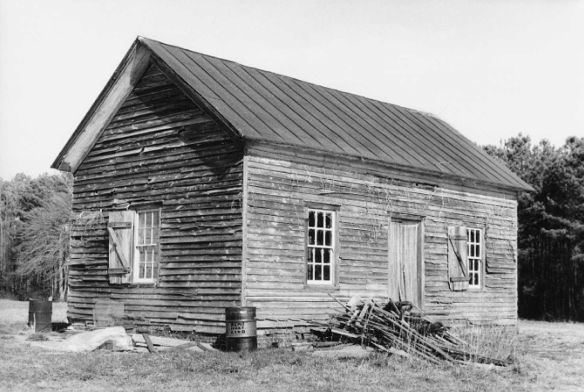  My tour ended when the light did, with several other destinations unreached—for the time being.  Thanks for joining in my adventures. It was a weekend full of cultural, historical, scenic, and (of course) driving bliss. The mighty Z4 always seems to revel in whisking me from one fascinating place to another, whether at 6,500 rpm or barely above idle. And the sport suspension and M seats provide plenty of cornering power and support, while soaking up (at least some of) the bumps. What a great vehicle for adventure-touring! Rick F. PS: As usual, unless credited otherwise, historical photos are courtesy of the Library of Congress. |
| 03-21-2014, 10:01 PM | #3 |
|
Lieutenant
   
9
Rep 452
Posts |
Another great spread, Rick. Thank you!
But to be frank, no travelogue of Delmarva is complete without some mention of Grotto Pizza. Seriously, you are enlightening us tremendously!
__________________
Vibra Technics engine mounts / Rogue trans mounts / Stoptech brakes / original owner
|
|
Appreciate
0
|
| 03-22-2014, 05:50 AM | #4 |
|
Lieutenant Colonel
 11379
Rep 1,793
Posts
Drives: E86 3.0si
Join Date: Oct 2011
Location: Susquehanna Valley
iTrader: (0)
Garage List '55 Ford F100 [0.00]
'08 Z4 3.0SI [8.50] '66 Triumph TR4A [0.00] '85 Corvette [0.00] '64 Corvette [0.00] '68 Triumph GT6 [0.00] '19 VW Golf "R ... [0.00] |
|
|
Appreciate
0
|
| 03-27-2014, 09:20 AM | #7 | |
|
Lieutenant Colonel
 946
Rep 1,910
Posts |
Quote:
Glad you liked the report! Now, if only I'd known about Grotto Pizza before the trip, I could have eaten much better than I did. I tend to drive and tour from sunup to sundown, eating only a couple of power bars in-between. But I would have made a stop for excellent pizza! Rick |
|
|
Appreciate
0
|
| 03-27-2014, 09:22 AM | #8 | |
|
Lieutenant Colonel
 946
Rep 1,910
Posts |
Quote:
Thanks much--I really enjoyed the tour, and it's always fun to do further research on the places I saw and to write up the report. I'm very glad that you and others like the results. Rick |
|
|
Appreciate
0
|
| 03-27-2014, 09:24 AM | #9 | |
|
Lieutenant Colonel
 946
Rep 1,910
Posts |
Quote:
My pleasure, as always! With the weather poised to improve soon, I can't wait for my next tour. Top-down motoring in the winter is a fun adventure, if a bit brisk at times, but there's nothing like a perfect spring day. Rick |
|
|
Appreciate
0
|
| 03-27-2014, 07:31 PM | #10 | |
|
Lieutenant
   
9
Rep 452
Posts |
Quote:
In any case, the weather should be improving soon, making your next reports much more comfortable for you!
__________________
Vibra Technics engine mounts / Rogue trans mounts / Stoptech brakes / original owner
|
|
|
Appreciate
0
|
| 03-27-2014, 08:32 PM | #11 |
|
First Lieutenant
  68
Rep 321
Posts |
Terrific Rick! I always enjoy your trips around the New England countryside. What a wonderful gift you have! Thanks for taking the time to share your pictures and excellent historical background.
|
|
Appreciate
0
|
| 03-28-2014, 05:42 PM | #13 |
|
First Lieutenant
  7
Rep 376
Posts |
Another fascinating story Rick!! I really enjoyed the part about Fort Monroe and the pictures of it. My great-grandfather ended up there after he escaped from Libby Prison in Richmond, VA in February, 1864. I think I may have missed a couple of your stories over the past few months. My Z4 was in semi-retirement for the winter and I hadn't been out on ZPOST much during that time. (everytime I come on ZPOST, I wanna drive it!) Have you thought anymore about becoming a high school history teacher? Your way of teaching us about history would probably keep the kids interested too!!
__________________
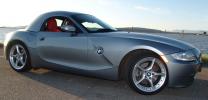 |
|
Appreciate
0
|
| 03-30-2014, 01:28 PM | #14 |
|
Second Lieutenant
 2
Rep 262
Posts |
Many thanks for the fantastic tour!
I have truly enjoyed your past tours and always look forward to your latest ventures. Have you considered putting together a coffee table book of your travels? Gotta love the "old school" cup holders on the Edsel....reminds me of how it used to be. :-) I had the same mags on a 1964 GTO that I owned when I was a teenager. Rader wheels was the brand, the same wheels that were on the original Batmobile. At the time, I couldn't wait to get rid of those dull aluminum rims and replace them with a brand new set of shiny Cragar SS wheels. The Raders were in perfect shape and a buddy ended up buying the set of four wheels, tires and lug nuts from me for $25.00! Thanks again for the trip down "Memory Lane".  |
|
Appreciate
0
|
| 03-30-2014, 05:42 PM | #15 | |
|
Lieutenant Colonel
 946
Rep 1,910
Posts |
Quote:
You make a good point about the importance of one's original pizza experience. In my case, I like pizza so much that I can happily adopt someone else's original experience and treat it as my own! I'll check Grotto out on my next trip through either Harvey's Lake or Rehobeth.  Rick |
|
|
Appreciate
0
|
| 03-30-2014, 05:44 PM | #16 | |
|
Lieutenant Colonel
 946
Rep 1,910
Posts |
Quote:
Thanks! I'll be headed back up to New England in June, and it should prompt another couple of tour reports--so stay tuned! Rick |
|
|
Appreciate
0
|
| 03-30-2014, 05:50 PM | #17 |
|
Lieutenant Colonel
 946
Rep 1,910
Posts |
dschultz,
Hey, glad you enjoyed it! There's also a "mystery-solving" aspect that I enjoy about these trips. Sometimes it relates to a name on a grave or written on a wall. Other times it's connecting a given person to multiple places in history. I got an email a few days ago from a nice young woman at the Maryland State Archives. She asked me about the location of an old stone house that I'd pictured in a trip report--from May 2007! That was before I had a GPS, so identifying its precise location turned out to be quite a challenge. However, I did manage to find it yesterday afternoon (with the help of a friendly State Park Ranger). It was fun to relocate several spots where I'd taken photos and piece those together into what my itinerary had been. Hopefully it will help Megan with her research on Triadelphia, MD--which now sits at the bottom of Triadelphia Reservoir… Rick |
|
Appreciate
0
|
| 03-30-2014, 06:01 PM | #18 | |
|
Lieutenant Colonel
 946
Rep 1,910
Posts |
Quote:
Wow, that's fascinating about your great-grandfather! It's good that he managed to escape from Libby Prison, which was one of the most notorious Confederate prisons and where the mortality rate from disease and malnutrition for Union prisoners was shockingly high. I probably won't become a history teacher anytime soon, although I have started doing some health care consulting work on a (highly) part-time basis. It's fun and pays well, but mostly I have to ensure that I have plenty of time in retirement for touring and writing about touring! You can check for any missing trip reports by doing an advanced search for threads started by Rick F. Or, if you want the complete list, all the way back to day one, you can get it at the BMWBMW motorcycle site at Rick F.'s Trip Reports. Hope you (i) enjoy catching up on your reading, and (ii) getting back out on the road soon! Rick PS: It's snow yet again here in Maryland as we speak.  |
|
|
Appreciate
0
|
| 03-30-2014, 06:06 PM | #19 | |
|
Lieutenant Colonel
 946
Rep 1,910
Posts |
Quote:
Glad you enjoyed the tour report! I really liked the custom Edsel. Thanks for the info about the Rader vs. Cragar wheels--my hotrodding memory isn't as thorough as it used to be! One of the things I liked best about the Edsel was how the owner had fitted auxiliary gauges in all the dash binnacles. He kept the original "circular" speedometer. The push button controls for the automatic transmission are still in the center of the steering wheel, just like on the original car, although the trans is now controlled by the Hurst floor shift. $25.00 for wheels, tires, and lug nuts, eh? That reminds me of when I sold my coin collection for $30 and used the proceeds to buy my first electric guitar! Rick |
|
|
Appreciate
0
|
| 04-04-2014, 07:31 PM | #20 |
|
Iron Ring

11
Rep 316
Posts |
Fascinating!
Happy I came back to search for your post.
Excellent narrative. incredible photographs. great experience reading your tale, and feeling like an imaginary friend enjoying your top-down-tour. Now I know what high-balling is! I always thought it had something to do with doses of liquid courage....alcohol Your winter looks magical. Our 911 hasn't seen daylight since we uncovered it for a January oil change. A neighbour has just acquired a new 335 tin-top. I saw it the other day for the first time, heard it run. Perhaps we should have kept our 2007 variant. Lovely car; faster than our '03 M3 cab. at least, I think it was. thanks Dave
__________________
DaveL///Toronto. http://www.ironring.ca/
My wife's cars: Had a few... I'm the Navigator, capable of getting us lost at any time! Drives are longer! |
|
Appreciate
0
|
| 04-10-2014, 09:39 PM | #21 | |
|
Lieutenant Colonel
 946
Rep 1,910
Posts |
Quote:
Good to hear from you, as always! I'm glad you enjoyed the report--but now I've got to work on a new one. I just returned from 2 days driving up the New Jersey side of the Delaware River and then down the Pennsylvania side. It was a fun trip, with great weather, and I even got to stay overnight in a gristmill that had been converted to an inn. And the new 335i performed flawlessly! Rick |
|
|
Appreciate
0
|
| 04-13-2014, 04:09 PM | #22 |
|
Iron Ring

11
Rep 316
Posts |
Incredible Rick. We have had the 911 out the last two days. topdown.
The back seat is folded down. We went back roads to Cambridge, from Toronto. we have used wind deflectors in the back seat of our cars, including the 335 cabriolet. Extends the top down season nicely! comes with a pouch for trunk storage.
__________________
DaveL///Toronto. http://www.ironring.ca/
My wife's cars: Had a few... I'm the Navigator, capable of getting us lost at any time! Drives are longer! |
|
Appreciate
0
|
Post Reply |
| Bookmarks |
|
|